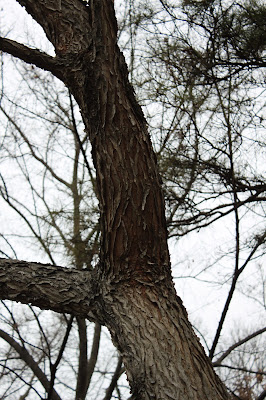In our contemporary situation of free and easy global trade, yearly consumption of coffee beans amounts to almost 25 billion pounds. You can get a cup almost anywhere, anytime. But since Coffea arabica can only be grown in a relatively few environments, war or trade embargoes can easily cut off coffee supplies to most places on earth. Due to this problem and the recognized benefits of the drink, coffee substitutes have often been sought and utilized. Today we'll showcase the arboretum's Kentucky coffee-tree (Gymnocladus dioica).
It isn't native to Louisiana. The map below shows that the plant is really a Midwestern fellow, with its distribution dipping down into the southeast.
There are two Kentucky coffee-trees growing in the arboretum. There is a big one, and right next to its trunk, there is a little one, which is clearly waiting for one of the surrounding trees to die so that it might have a chance to grow. These two trees do not have an official entry in the arboretum catalogue. They are mentioned elsewhere, in regards to other plants, but their specific planting history is missing. In an entry for spiderwort, the Kentucky coffee-tree is mentioned: "Another large clump [of spiderwort] with the seedling Gymnocladus dioica, below iris bed in west floodplain, planted 1999." A Kentucky coffee-tree seedling was growing in a pot with spiderwort, and they were planted together in the west floodplain in 1999. So, the Kentucky coffee-tree is at minimum 25 years old. According to the Iowa University Agriculture and Natural Resources Extension, the tree should be sexually mature and fruit-bearing once aged 20-30 years. Interestingly, this tree came to our attention this week because we found an unusual seed pod in the leaf litter.
 |
| Two more fruits were found. One is significantly larger. |
 |
| The larger pod has one seed. |
 |
| It's a large seed, mearsuing approximately one inch across. |
 |
| The seed is round and dark brown. |
As with the Yapuon holly (Ilex vomitoria), the Native American Indians of the Southeastern Woodlands are reputed to have consumed a tea made from the seeds of Gymnocladus dioica. The paucity of consumer goods in colonial times, being a major issues for homesteaders and travelers, there has been interest in this tree's seed since at least the late 18th century. Some people employed the Kentucky Coffee-Tree as a coffee-substitute up to and possibly during the American Civil War, when a Union blockade cut off the Confederate States of America from international trade. It was greatly inferior to the alternatives, such as chicory and scorched barley, as an uncaffeinated coffee substitute. Experiments performed by John P. Spaeth and John W. Thieret in the earlier 2000s showed that although potable, this drink was generally squalid. While true coffee addicts would consider such a product little better than a criminal act, a hot herbal beverage is better than nothing on cold days and long nights. Let's now check out the specimen itself.
 |
| The wish-bone shape of this tree is no doubt a response to growing in heavily-shaded conditions. This tree is clearly adaptable. |
The photos below were taken during the winter months. They allow us a less-cluttered view of the landscape.
 |
| Clumps of spiderwort (Tradescantia ohiensis) grow at the base of the Kentucky coffee-tree trunk. Spiderwort was planted at the same time as the coffee-tree. |
 |
| Kentucky coffee-tree has gorgeous papery bark. |
 |
| The tree has an irregular growth pattern, as noted above. Hopefully this will not lead to cracking and breaking in the future. |
Additional resources:
USDA Plant Profile on Kentucky Coffee-Tree




